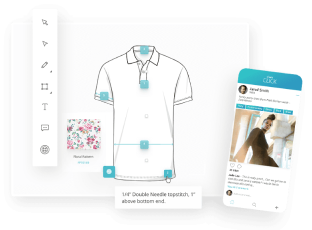How PLM can help you improve product quality
Introduction
An increasing number of people are beginning to realize that clothing is a product like any other. Many feel that it’s better to invest in a few good quality garments rather than buying numerous pieces that might fall apart quickly.
A lot has been said about how fast fashion is ruining our planet. Meanwhile, the ethos of slow fashion is also becoming more and more popular. Customers now prioritize quality and want products that look good, fit well, and last longer.
However, you should not think that quality means taking more time to create something. Quality is about doing things right the first time and reducing waste at every stage – from design to disposal. In fact, maintaining high product quality is the smartest fashion marketing strategy for competing in such a competitive and crowded market.
Today’s consumer is constantly comparing two products of a similar price and looking for one that offers the best value. In this context, brands, retailers and manufacturers have to keep up with the consumer’s move towards quality goods and services.
How can you improve product quality without hurting your bottom line?
Delivering a good quality product means you satisfy your customers’ needs and serve a meaningful purpose in their lives. The first step is to design a great attractive product and most companies can do this just fine. The second step is getting production right, every step of the way. This is where many fast-growing businesses tend to struggle.
This is because it’s utterly impossible to make good quality, sustainable products without technology. Software and technology have been the catalyst for progress in almost every aspect of our lives. For fashion brands, a Product Lifecycle Management (PLM) software is the easiest way to improve product quality and remain competitive.
6 ways Fashion PLM can help you improve product quality
Let’s learn how PLM can help you take your products from good to great!
1. Immediate damage control
When you run a business involving multiple teams, processes and resources, you will most likely face hiccups in the supply chain. This situation may be out of your control, but you can react to it much faster with a PLM. A PLM platform with the right tracking features allows you to keep tabs on the entire design and development process.
Being able to track processes means you can fix problems as they happen and prevent further escalation. Your quick response time directly contributes to reducing wastage and ensuring you end up with high quality production.
2. Improved vendor communication
The product design and manufacturing teams have a mutual responsibility to ensure that your products meet the highest quality standards. If you can’t get the clothes that you’ve designed, or if the pieces you’ve received aren’t built to the agreed upon specifications, then you’re not going to be able to produce high-quality products.
This is often a problem of communication which can be solved through a vendor portal on the PLM itself. Your vendor should be able to view all necessary product details on the software. A good fashion PLM allows you to share product data with your manufacturer and supplier in real-time. This helps improve communication and makes it easier to collaborate on designing and developing the product. With everyone looking at the same information, you can reduce errors and inconsistencies in your development process.
3. Allocate tasks more effectively
A product lifecycle management solution gives you the ability to clearly see what tasks are managed by which team member. With greater visibility, comes greater control. You can make sure that each team member has the tools they need to complete their tasks and that they are using them in the right way. You will also be able to identify where the quality problems may lie and correct them.
PLM software also allows you to track and monitor the status of all tasks taking place in your organization. This means greater efficiency and less waste of both time and money. Greater efficiency also means more time for innovation and creativity.
With PLM you can move away from a culture that relies on last-minute firefighting and instead focus on long-term quality improvement, as well as planning how to achieve it.
4. Make the sampling process more robust
Product sampling is an integral step in the product development process. It enables you to test new products and check whether they are good enough to be sold on the market. It also helps identify any potential issues with the design before they happen.
With PLM, you can create your own sampling plan and request samples at any time with a simple click of a button. You can also use this tool to track all samples in one place, whether they are standard or custom made according to your specifications.
You can give feedback on each sample in the dedicated space without having to go back and forth with suppliers over email or via phone calls. You can upload images and annotate any design changes on the platform for everyone involved in the project to see.
5. Keep up with your compliance commitments
In an industry where quality and compliance issues can have devastating consequences – not only for the company but for the consumer as well – it’s important to have a solution that can help you keep up with your compliance commitments.
In many cases, companies use a paper-based system to manage inspections, requiring inspectors to carry around clipboards, which can be inaccurate and time consuming. The software solution instead provides a schedule for inspectors to manage and report on factory audits digitally, helping them to be more efficient and effective while saving tons of time.
While using PLM software doesn’t guarantee quality or compliance, it does streamline processes and helps you gain control over your product lifecycle. This in turn can help you improve product quality and keep up with the latest compliance regulations.
6. Use data to get better with every launch
Many companies struggle to keep track of product quality over time, often because they don’t have a system in place which allows them to easily do so.
PLM gives you access to all the right information to help you plan and make better decisions before development even begins. A PLM software enables brand managers to access data from previous seasons and collections and use it to inform current design and development decisions.
With a powerful analytics tool, you can access reports on everything from who was most efficient at delivering to where you had the most space for improvement in your last season. You’ll know immediately if a supplier is having trouble meeting deadlines or if there’s a problem with materials or shipping delays so you can adjust before it becomes a costly problem. Use this data to make decisions that will benefit your future projects.
Summary
Software improves communication, that’s something no one doubts, but can it also help improve product quality? Yes, it can. The introduction of PLM has made it possible to achieve better workflow, transparency, process control and in turn, improve the quality of your end product.
In due course, it is obvious that with the right PLM software you will be able to control product quality better and keep it similar for all your customers. It will simplify your data collection and analysis by using both qualitative and quantitative data. And it will help easily manage your supply chain, reduce costs, and work better together with suppliers. For your fashion or accessories brand, this means an increase in profits and an assurance of satisfied customers.
Ready to improve your product quality? Find out how WFX Fashion PLM can help with a free product demo!







